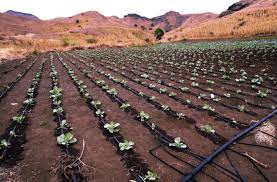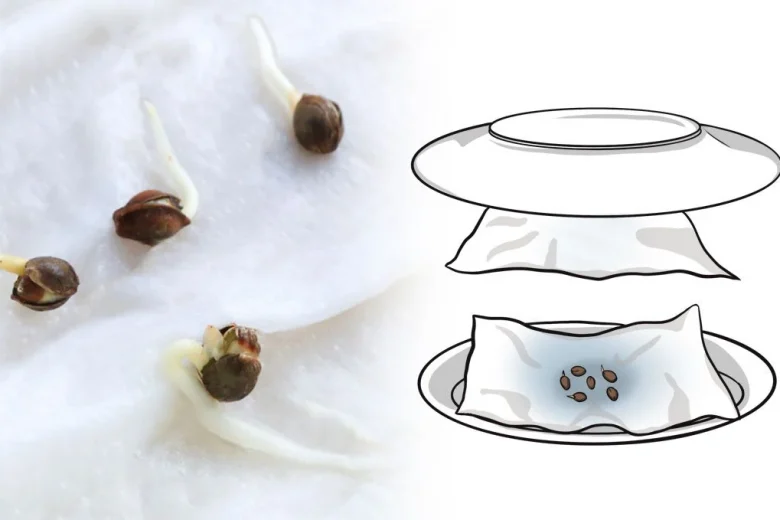South Africa is an incredibly diverse nation, with a wide range of climates, soils, and plants. With this in mind, you need to find the most effective and efficient irrigation systems to ensure optimal growth and yield of the crops.
The best irrigation techniques for plant cultivation in South Africa varies. These methods include drip irrigation, sprinkler irrigation, surface irrigation, sub-surface irrigation, fertigation, and fogging.
Each of these methods has its advantages and disadvantages, and we will explore them in further detail. We will also discuss the costs associated with each irrigation technique.
With the right approach, you can use the best irrigation techniques to maximize crop yields and promote optimal growth.
6 Best Irrigation Techniques for Plant Cultivation in South Africa PDF
Below is the list of the 6 best irrigation techniques for plant cultivation in South Africa.
#1. Drip Irrigation
Drip irrigation is a low-volume water delivery method that slowly and evenly applies water directly to the soil near the roots of plants. Water is delivered through a network of small tubes, known as drip lines, which are laid out in rows alongside the plants.
The water is released in a slow, steady stream and is absorbed directly into the soil. This type of irrigation requires minimal water and can be tailored to the plants’ specific needs.
Steps for Proper Implementation
Step 1. Design the system
Start by designing the system, taking into account the type of plants, the size of the area to be irrigated, and the available water resources.
Step 2. Install the system
Install the system, making sure to lay out the drip lines in rows and ensure that the lines are not blocked by debris.
Step 3. Connect the system to the water source:
Connect the system to the water source, such as a well or a water tank.
Step 4. Program the system
Program the system to deliver water at the appropriate time and rate for each type of plant.
Step 5. Monitor the system
Monitor the system regularly to ensure that it is functioning properly and that the plants are receiving the appropriate amount of water.
Advantages
Drip irrigation has several benefits, including:
Reduced water usage:
By delivering water directly to the soil, drip irrigation can reduce water usage by up to 60%. This is important in a country with limited water resources.
Reduced runoff:
Drip irrigation reduces runoff, which can help prevent soil erosion and protect water quality.
Improved yields:
Drip irrigation can improve crop yields by delivering water directly to the plant’s roots. This helps to optimize growth and reduce stress on the plants.
Reduced costs:
Drip irrigation can reduce costs by reducing water usage and labor required for manual watering.
Improved soil health:
Drip irrigation helps to improve soil health by reducing soil compaction and promoting root growth.
Disadvantages
- Expensive to Install – Drip irrigation systems can be expensive to install and require some technical knowledge to set up.
- High Maintenance – Drip irrigation systems require regular maintenance to ensure that they are functioning properly.
- Clogging – Drip irrigation systems can be prone to clogging, which can reduce the effectiveness of the system.
- Susceptible to Damage – Drip irrigation systems are susceptible to damage from rodents and other animals.
- Limited Coverage – Drip irrigation systems are limited in the area they can cover, and may not be suitable for large areas.
Cost of Drip Irrigation in South Africa
The cost of drip irrigation in South Africa varies depending on the size and type of system you are looking for. Generally, a basic drip irrigation system for a small garden or vegetable patch will cost between R3,000 to R7,000. However, for larger or more complex systems, the cost can range from R20,000 to R50,000 or more.
#2. Sprinkler Irrigation
Sprinkler irrigation is a method of irrigation that is used to water crops in South Africa and many other parts of the world. It is a type of surface irrigation that involves the use of sprayers, sprinklers, and other irrigation systems to water crops in a controlled manner.
This method of irrigation is used to minimize water wastage, maximize crop yields, and reduce labor. It is an efficient and cost-effective way to irrigate crops.
Steps Involved in Sprinkler Irrigation
Select a Sprinkler System
The first step in implementing a sprinkler irrigation system is to select a suitable sprinkler system. Depending on the size of the area to be irrigated, different types of sprinkler systems are available. The most commonly used systems are overhead sprinklers, rotary sprinklers, and drip irrigation systems.
Install the Sprinkler System
Once a suitable system has been selected, it needs to be installed in the designated area. This involves digging trenches and laying the pipes, attaching the sprinklers, and connecting the system to a water source.
Set Up a Water Timer
To ensure that the irrigation system is efficient, it is important to set up a water timer. This will allow you to control the amount of water that is used to water the crops and minimize water wastage.
Set Up a Fertigation System
Fertigation is the process of applying fertilizer to crops through irrigation. It involves adding fertilizer to the irrigation water and applying it to the crops. This system can be used to maximize crop yields and reduce labor.
Monitor the System
Once the sprinkler system has been installed, it is important to monitor the system to ensure that it is working properly. This involves checking the system for any leaks or blockages, ensuring that the water pressure is correct, and making sure that the water is evenly distributed throughout the field.
Advantages
- Sprinkler irrigation uses significantly less water than other irrigation systems, as it is targeted directly at the plant’s root zone. It becomes more efficient, reliable, and cost-effective.
- Sprinkler irrigation is ideal for areas with irregular terrain, as they can easily be adjusted to reach different heights and slopes.
- This type of irrigation is also very flexible, allowing you to water different parts of your landscape separately.
- It can be used to water plants of all sizes, from large trees to small flower beds.
- Sprinkler irrigation systems are easy to install, maintain, and repair.
Disadvantages
- Sprinkler irrigation systems require a relatively large upfront investment and can be more expensive than other types of irrigation.
- These systems are more susceptible to damage from animals, wind, and other environmental factors.
- They can also cause runoff and can be wasteful in areas with frequent rain.
- Furthermore, sprinkler irrigation systems require more frequent maintenance and can be labor-intensive to install.
Cost of Sprinkler Irrigation in South Africa
The cost of a sprinkler irrigation system in South Africa varies greatly depending on the size and scope of the system, as well as the type of components used. A basic system with minimal components could cost as little as R5,000, while an advanced system with more features could cost upwards of R50,000 or more.
#3. Surface Irrigation
Surface irrigation is the most common type of irrigation used in South Africa. It involves the use of channels, ditches, and furrows to deliver water to the crops and is highly effective in providing an even distribution of water to the plants. Surface irrigation is an important component of crop cultivation and is used to ensure that crops receive the necessary water to grow and develop.
Types of Surface Irrigation
Surface irrigation can be divided into two main categories: furrow irrigation and basin irrigation.
Furrow Irrigation
Furrow irrigation involves the use of shallow, parallel trenches to deliver water to the crops. This type of irrigation is best suited to flat terrain and can be used to water crops in rows.
Basin Irrigation
Basin irrigation involves the creation of small basins or depressions around the crops. Water is then delivered to these basins and allowed to soak into the soil. This method of irrigation is best suited to hilly terrain.
Steps Involved in Sprinkler Irrigation
The installation of a sprinkler irrigation system requires a few steps:
Step 1. Prepare The Site
Before beginning installation, the area must be prepared. This includes digging trenches for the pipes and connecting them to the water source.
Step 2. Install The Pipes
Once the trenches are dug, the pipes must be laid and connected to the water source. It is important to use the correct type of pipes for the system.
Step 3. Install The Sprinkler Heads
Once the pipes are in place, the sprinkler heads must be installed. The sprinkler heads must be correctly positioned to ensure even coverage over the area.
Step 4. Connect The System To The Water Source
The final step is connecting the system to the water source. This is done by connecting a hose to the water source and running it to the sprinkler heads.
Step 5. Test The System
After installation is complete, the system should be tested to ensure that it is working properly. This can be done by running the sprinklers for a few minutes to ensure that they are functioning correctly.
Tips for Effective Surface Irrigation
- Ensure that the channels and furrows are the correct size and are properly maintained to ensure an even distribution of water.
- Monitor the rate of water delivery to ensure that plants are receiving the correct amount of water.
- Use mulch to reduce water loss through evaporation.
- Use water-efficient irrigation techniques, such as drip irrigation, to reduce water loss.
Advantages
- Surface irrigation is an inexpensive and efficient method of providing water to crops.
- It is relatively easy to install and maintain and can be used for large and small areas.
- It is also a more sustainable method of irrigation than other types of irrigation, as it does not require the use of pumps or other energy-intensive methods of water delivery.
- Surface irrigation is well-suited to South Africa’s climate and soil types.
Disadvantages
The main disadvantage of surface irrigation is that it is less efficient than other types of irrigation. This is because much of the water is lost to evaporation and runoff.
Also, surface irrigation can be labor-intensive and requires regular monitoring and maintenance to ensure that crops receive an even distribution of water.
Cost of Surface Irrigation in South Africa
The cost of surface irrigation in South Africa varies depending on the size of the land, the type of irrigation system, and the complexity of the installation. Generally, the cost of surface irrigation can range from R50,000 to R500,000.
#4. Sub-Surface Irrigation
Sub-surface irrigation is an irrigation technique that utilizes underground water sources and precipitation to irrigate crops. It is a type of irrigation system that is gaining popularity among farmers due to its low cost and water-saving capabilities.
Sub-surface irrigation is especially beneficial in areas with limited access to surface water or areas where surface water is not consistently available. In South Africa, sub-surface irrigation is becoming increasingly popular as it offers a cost-effective and sustainable way to irrigate crops.
Installation and Maintenance of Sub-Surface Irrigation Systems
Installing a sub-surface irrigation system requires careful planning and attention to detail. It is important to consult a qualified irrigation specialist to ensure that the system is installed correctly. Once the system is installed, it is important to inspect it periodically to ensure that it is functioning correctly.
Types of Sub-Surface Irrigation Systems
Many different types of sub-surface irrigation systems are used in South Africa. Some of the most common types of sub-surface irrigation systems include:
Drip irrigation:
Drip irrigation is a type of sub-surface irrigation system that utilizes a network of pipes, valves, and emitters to slowly release water to plants. It is the most common type of sub-surface irrigation system used in South Africa.
Sprinkler irrigation:
Sprinkler irrigation is a type of sub-surface irrigation system that uses a network of pipes and sprinklers to disperse water over a large area. It is often used to irrigate large fields and crops.
Sub-surface drip irrigation:
Sub-surface drip irrigation is a type of sub-surface irrigation system that utilizes a network of pipes and drip emitters to slowly release water to plants. It is a more efficient way of irrigating plants than traditional drip irrigation systems.
Sub-surface bubbler irrigation:
Sub-surface bubbler irrigation is a type of sub-surface irrigation system that utilizes a network of pipes and bubblers to slowly release water to plants. It is less expensive and more efficient than traditional surface irrigation systems.
Advantages
Increased Water Efficiency
Sub-surface irrigation systems are designed to be highly efficient, utilizing up to 70% less water than traditional surface irrigation systems.
Reduced Evaporation
By irrigating crops underground, the risk of water loss due to evaporation is greatly reduced.
Reduced Risk Of Disease And Pests
By keeping the soil moist and cool, sub-surface irrigation can help reduce the risk of crop diseases and pests.
Improved Crop Yields
Sub-surface irrigation systems are designed to provide an even distribution of water, which can result in improved crop yields.
Reduced Labour Costs
Since sub-surface irrigation systems do not require manual labor for installation or maintenance, labor costs are reduced.
Disadvantages
Expensive to Install and Maintain:
Sub-surface irrigation systems require a lot of specialized equipment and materials for installation, and they can be expensive to maintain over time.
Limited Areas:
Sub-surface irrigation systems are best suited for areas where there is a high water table, or where soil drainage is poor.
Leaching of Nutrients:
The water used in sub-surface irrigation systems can leach away important nutrients, such as nitrogen and phosphorus, from the soil.
High Risk of Contamination
There is a high risk of contamination with sub-surface irrigation systems, as they are prone to breakage and leaks.
Cost of Sub-Surface Irrigation in South Africa
The cost of sub-surface irrigation in South Africa varies depending on the size of the land, type of system, and region. Generally speaking, the cost of a sub-surface irrigation system in South Africa can range from approximately R1,500 to R12,000 per hectare (2.47 acres). Additional costs may include the installation, repair, and maintenance of the system.
#5. Fertigation
Fertigation is a technique of irrigation used in plant cultivation that combines fertilization with irrigation. This method of fertilization is gaining popularity in South Africa due to its ability to improve crop yields and reduce water waste.
Fertigation utilizes water-soluble fertilizers that are applied through the irrigation system, allowing for more efficient and effective use of fertilizer while reducing the risk of runoff and leaching.
Setting Up a Fertigation System
Before setting up a fertigation system, it is important to understand your soil type and the type of crops you will be growing. This will help determine the type of fertilizer needed and the rate of application. It is also important to choose the right type of irrigation system for your fertigation needs.
Once the type of irrigation system is chosen, the next step is to set up the fertigation system. This includes installing the fertilizer injector, the irrigation system, and the nutrient solution.
The injector is responsible for mixing the fertilizer into the irrigation water, and the irrigation system distributes the fertilizer to the root zone. The nutrient solution is then added to the irrigation system, and the fertigation system is ready to go.
Advantages
Fertigation is a great way to ensure that plants receive the right amount of nutrients at the right time, resulting in improved crop yields. Fertigation also helps reduce the amount of water used, as the water-soluble fertilizers are absorbed directly into the root zone.
Also, fertigation can reduce the risk of nutrient run-off and leaching, as fertilizers are applied directly to the soil. This method of fertilization is also more cost-effective than traditional fertilization methods, as it requires less labor and materials.
Disadvantages
Fertigation can be difficult to set up and can be costly if not done properly. Additionally, if the fertigation system is not managed properly, it can lead to over-fertilization or nutrient deficiencies, which can result in poor crop yields. Additionally, fertigation can be hazardous to the environment if not managed properly, as the fertilizers can enter into surface and groundwater sources.
Cost of Fertigation Irrigation in South Africa
There is no one-size-fits-all answer to this question as there are many factors that can affect the cost of a fertigation irrigation system in South Africa. These include the size and design of the system, the quality of the components used, and the labor costs involved in installation and maintenance. Generally, a basic fertigation irrigation system can cost anywhere from R45,000 to R150,000 in South Africa.
#6. Fogging
Fogging is a method of irrigation used in South Africa to help promote efficient water usage and to ensure that crops receive the right amount of water. Fogging is a type of irrigation technique that uses a fine mist to deliver water and other nutrients to the crops. This method is especially suitable for small-scale operations and can be used in a variety of crops such as vegetables, fruits, and flowers.
Installation of Fogging
Before you start fogging, you need to determine the best approach for your particular situation. Consider the size of the area you are trying to irrigate, the soil type, and the type of crops you are growing.
Once you have determined the best approach for your situation, the next step is to set up the fogger and ensure it is working properly. Make sure the fogger is placed at the correct height and that all the nozzles are positioned correctly. Check that the fogger is producing an even mist and that the water droplets are the right size.
Once the fogger is set up and working properly, you can begin fogging. Start by fogging the areas that need the most water first and then move to the areas that require less water. Fogging can be done at different intervals, depending on the crops you are growing and the soil type.
Tips for Successful Fogging
When fogging, it is important to ensure that the right amount of water is being delivered to the crops. Too much water can lead to runoff, while too little can lead to insufficient hydration. Monitor the water levels to ensure that the crops are receiving the right amount of water.
Make sure to clean the fogger regularly to ensure that it is working properly. This will also help to reduce the risk of disease by preventing the buildup of bacteria and other organisms.
Ensure that you are using the right type of water for your crops. Some crops may require soft water, while others may require hard water.
More so, pay close attention to weather conditions when fogging. If it is too windy, the water droplets may be blown away, while if it is too hot, the water droplets may evaporate too quickly. Monitor the weather and adjust your fogging schedule accordingly.
Advantages
- Fogging is an efficient method of irrigation. The mist created by the fogger helps to reduce evaporation and the water droplets can penetrate deeper into the soil.
- This helps to reduce water wastage and ensure that the crops get the right amount of water.
- Fogging also increases the efficiency of water usage as the water droplets can reach more plants and be more evenly distributed throughout the area.
- Fogging also helps to reduce the risk of disease, as the water droplets are small and less likely to carry disease-causing organisms.
- The mist created by the fogger also helps to reduce the rate of evaporation and helps to keep the environment cool.
Disadvantages
- It is not suitable for areas with high winds, as the droplets can be scattered and blown away.
- Fogging irrigation is more expensive than traditional sprinkler irrigation.
- It does not provide enough water for deep-rooted plants and crops.
- It can increase the risk of disease spread among plants.
- Fogging irrigation can create an ideal environment for insect breeding and hatching.
- It can also lead to water waste due to the small droplets being unevenly distributed.
Cost of Fogging Irrigation in South Africa
The cost of fogging irrigation in South Africa will depend on the size of the area being covered, the type and quality of the equipment being used, and the climate conditions of the area. Generally, fogging irrigation systems can range from a few hundred Rand to thousands of rand. Professional installation and maintenance are also factors that can increase the cost.
1 Hectare Drip Irrigation Price
The cost of drip irrigation systems varies widely, depending on the size of the system, features included, and other factors. Generally, the cost of a 1-hectare drip irrigation system can range from $10,000 to $20,000.
Irrigation Systems
Irrigation systems are used to provide water to agricultural fields. They are designed to deliver water to crops in a controlled and consistent manner, allowing you to produce crops in areas with limited water resources. Irrigation systems can include canals, ditches, sprinkler systems, and drip irrigation. They allow farmers to use their water resources efficiently and help maximize crop yields.
Spray Irrigation
Spray irrigation is a type of irrigation system in which water is sprayed onto the soil surface in a fine mist or spray. This method of irrigation is often used on small plots of land, such as in greenhouses, orchards, and nurseries.
It is also used on larger fields, such as golf courses, parks, and crop fields. The purpose of spray irrigation is to ensure that the water is evenly distributed across the entire area. This method of irrigation is efficient and cost-effective and helps reduce water loss through evaporation.
Garden Irrigation System
Garden irrigation systems are designed to provide water to plants and lawns. They typically involve a network of pipes or hoses and sprinklers that distribute water evenly and efficiently over a designated area. These systems can be manual or automated and can be used to water both indoor and outdoor gardens.
1 Hectare Drip Irrigation Layout Pdf
A 1 Hectare Drip Irrigation Layout PDF is a document that provides information about the layout of a drip irrigation system for a hectare of land. The document typically includes a diagram of the area, outlining the system’s components and their locations.
It also provides information about the types of materials needed for the system, such as pipes, fittings, and emitters, as well as the number of emitters, their flow rate, and the proper spacing between them.
In addition, the document may provide information on the design and construction of the system, such as the proper depth of the trenches and the best installation techniques.
1 Hectare Drip Irrigation Price
A 1-hectare drip irrigation layout is a system of pipes, emitters, and valves which are used to deliver water to a specific area. The system is designed to provide an even, efficient, and reliable delivery of water to the crops in the field. The layout typically consists of mainline, sub-mains, and lateral lines which connect to the emitters and valves.
The emitters and valves are used to regulate the water pressure and flow rate to the crops. This allows the farmer to optimize their water usage and ensure that the crops receive the optimal amount of water.
Conclusion
The article concludes that South Africa has a great variety of irrigation techniques that can be used for plant cultivation. These techniques range from manual watering to sophisticated systems such as drip and sprinkler irrigation. Each technique has its advantages and disadvantages and should be carefully considered when selecting the best option for a particular application. With careful planning and careful management, you can successfully use any of these irrigation techniques to produce high-quality crops.





